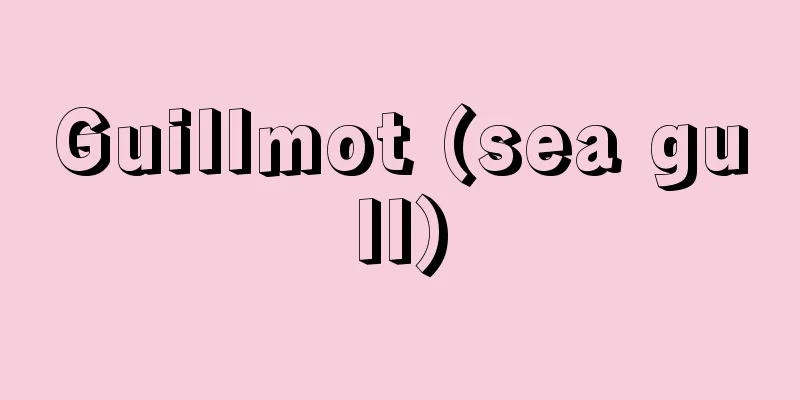Political party - Seito (English spelling)

|
It is said that political parties are the lifeblood of modern politics (S. Neumann). It is certainly impossible to understand the dynamics of modern politics without considering the issue of political parties. Under the various modern political systems, political parties have quite different forms (both in terms of party structure and party system) and roles or functions, but with a few exceptions, the fact remains that political parties occupy a crucially important position in almost all political systems. In other words, one of the important keys to understanding the operation of a particular modern political system is to accurately grasp the nature, placement, and political role of political parties within that system, along with the bureaucracy, pressure groups, and citizen movements. [Taguchi Fukuji] Definition and Function of Political PartiesIt is very difficult to give a universal and objective definition of a political party. This is because the concept of a political party, like all political concepts, is inherently a controversial concept, but also because the actual nature of the political phenomenon known as a political party varies greatly and changes over time, between countries, and even among countries with similar national and political forms at roughly the same historical stage. I will touch on this point later, but for now, let me give a few representative definitions of political parties given by political scientists after the Second World War. "A political party is a political organization that controls through resistance and agreement" (Yoshitatsu Oka), "A political party is an autonomous and continuous social organization that operates under a modern parliamentary system with the aim of controlling the political process, especially the acquisition and maintenance of power" (Shinichi Endo), "A political party is any political group that can appear in elections and have candidates elected to public office through elections" (Sartori's minimal definition), and so on. These definitions differ in their aims, comprehensiveness, and level of abstraction, but what they have in common is that political parties, based on the relative separation between civil society and the political state in modern society, started out as a kind of voluntary association that resisted political power and functioned as a channel for citizens to express their will to the power, and eventually established themselves as central political organizations that assumed governing functions. In functional terms, this would be said to be "a central intermediate or mediating structure that exists between society and the government" (Sartori). Of course, the devices that mediate between society and the government are not limited to political parties, but also include bureaucracy, political interest groups, and citizen movements. However, while bureaucracy is a device for the government to control society, political parties are distinguished from each other in that they are voluntary groups that have their foothold in society, often in opposition to bureaucracy, express and convey the will of society to the government, and assume governing functions by consolidating and organizing it. Political parties also share a common function with interest groups and citizen movements in expressing and communicating the will of society to the government, but as shown in the minimum definition of a political party by G. Sartori (1924- ), they are distinct from the latter two in that they appear in elections and can elect their candidates to public office through elections.The British political scientist Sir Ernest Barker (1874-1960) declared that "a political party is a bridge with one foothold in society and the other in the state," which aptly captures the character of political parties as a central political intermediary that straddles both the realms of society and government. The functions that political parties with the above-mentioned intermediary characteristics play in modern politics, especially in modern representative systems, are as follows: [Taguchi Fukuji] The Establishment and Development of Political PartiesHere we will take a brief look at the history of political parties in Britain, which saw the birth and development of the first political party in history. There are various theories about their origins, including some that trace them to the Puritans under the Elizabethan era, others that trace them to the conflict between Parliamentarians (Roundheads) and Royalists (Knights, Cavaliers) during the Long Parliament, and still others that trace them to the Whigs and Tories under the Glorious Revolution. In any case, it is significant that modern political parties were established during the revolutionary struggle against absolute monarchy and the process of settling it. Simply put, political parties were the children of the first civil revolution in history. What is particularly noteworthy about this process is that, first, the Puritan factions that appeared in the Revolution (Presbyterians, Independents, etc.) started out as resistance to or opposition to power in the conflict between the monarchy and Parliament, and then Parliament and the revolutionary army, and progressed to the exclusive seizure of power (Cromwellian dictatorship), and second, through this process of dictatorship, the foundations of the Glorious Revolution system were laid in England, a system of political control through Parliament by the bourgeois landlords and the landlordized upper bourgeoisie, and here a two-party system within the system, that is, the two-party system of the Tories and the Whigs, was established to replace the settlement of conflicts by violence. Similar circumstances were also seen in the American Revolution, which occurred more than a century after the English Revolution. In other words, here too, the conflict between royalists and revolutionaries during the Revolution was replaced by a conflict between moderates and radicals within the Revolution after the Revolution was successful (after the expulsion of the royalists), and eventually these conflicts shifted into conflict between Federalists and Anti-Federalists within the new regime. By the way, when the development of political parties is discussed using the Anglo-American model, especially the United Kingdom, the inseparability of the development of political parties and the development of representative or parliamentary systems (government accountability to Parliament) is often emphasized. It is true that in Britain, the development of parliamentary systems throughout the 18th century after the Glorious Revolution promoted the development of political parties as loose associations of members within Parliament (parliamentary parties), while the severity of party struggles led to the formation of a system of cabinet accountability to Parliament (parliamentary cabinet system) (particularly the dominance of the Whigs under Walpole and Bellum from 1715 to 1760). Ironically, the efforts of George III, who ascended to the throne in 1760, to restore sovereign powers by creating "Friends of the King" within Parliament, only ended up confirming the status and function of political parties in the constitutional order. The subsequent development of British political parties can be described as an evolution from "accountability politics" (government responsibility to Parliament) to "responsive politics" (politics that listens to the voice of the people and is influenced by it) to "party politics" (governance or the assumption of government functions by political parties).During this time, the nature of political parties also evolved from prestigious parties and parliamentary parties to mass parties with strict party discipline and mass extra-parliamentary party organizations. However, what must be noted here is that the so-called "happy marriage" between the parliamentary system and the two-party system in Britain was due, first, to the fact that it was established after the severe religious conflict had been resolved, and second, before the country entered the Industrial Revolution. In other words, the intra-systematic, secular, and national character of Britain's two major parties is due to the historical circumstances unique to Britain, in that they were formed after religious confrontation had basically ceased to be a political issue, and before the serious conflict between labor and capital became all-out as a result of the Industrial Revolution. [Taguchi Fukuji] Political parties in continental countries and the United StatesHowever, the above conditions were generally lacking in the continental countries. That is, on the one hand, the conflict between clericalism and anti-clericalism over religion, especially Catholicism, prevented the formation of "national" political parties like those in England, and on the other hand, the development of parliamentary politics overlapped with the period of social change caused by the Industrial Revolution, so the problem of class conflict between labor and capital emerged as a serious political issue at a relatively early stage. For example, in France, political parties were divided by the "myths" of "left" and "right," and popular republicans and aristocratic and clerical restorationists, based on the ideals of the French Revolution and support for or against Catholicism. At the same time, they became increasingly diverse based on the re-division within each of the left and right wings (political parties as "tendencies": the fact that non-organized political parties centered on deputies repeatedly split and merged due to certain political tendencies during the Third and Fourth Republics in France). In the second half of the 19th century, the three tasks of national unification, democratization, and industrialization were put on the concrete agenda in close succession in the developing country of Germany. However, by that time the issue of socialism associated with industrialization had already emerged on the political stage, and these three tasks were carried out under the leadership of the Prussian bureaucracy, with Bismarck at its apex and the Junker aristocracy as its social base, and at the expense of the task of democratization. As a result, in the governing structure of the unified German Empire, not only was the power of the Reichstag significantly limited compared to that of the Emperor, but the parliament was also filled with conflicts between a number of political parties based on clear worldviews (especially in the case of the Centre Party and the German Social Democratic Party), such as the conservatives who had influence in East Germany, the National Liberal Party which supported Bismarck's domestic reforms as the mainstream of the German bourgeoisie, the Progress Party as an anti-Bismarck bourgeois left wing representing small and medium-sized export-oriented businesses and the free professions, the Centre Party which defended the demands of Catholics as a minority, and the Social Democratic Party as a party of the German working class that was initially organized outside parliament and acted as a principled anti-establishment party even within parliament (worldview parties). On the other hand, political parties and party organizations in the United States of America develop around the issue of obtaining and allocating patronage from the federal or state governments (patronage parties). The most important aspects of patronage are the presidential election and the election of executive officials such as state governors, so American political parties were organized to respond to these elections. Party organizations are called "machines" (the origin of which is said to date back to the election of President Jackson in 1828), and "bosses" appear as professional politicians and political entrepreneurs who control the "machines." In the United States, conflicts between political parties have long been viewed from the perspective of sectionalism, that is, conflicts between regional interests, because the conflicts between regional interests happened to coincide with the conflicts between class interests. Here too, however, the trend towards nationalisation of politics developed against the backdrop of widespread industrialisation and urbanisation after the Civil War, and with the advent of the F. D. Roosevelt administration, known as the "Revolution of 1932", as a turning point. As a result, the task of political reorganisation along class lines of the previous ideologically homogeneous and decentralised two-party system has been raised, but this has yet to materialise, at least in the form of the formation of an independent workers' party (labour unions are generally supportive of the Democratic Party). The lack of a strong workers' party based on some sort of socialist ideology is a phenomenon unique to the United States among the developed capitalist countries. [Taguchi Fukuji] Types of political partiesPolitical parties can be categorized based on their objectives, organizational structure, the basis for their existence, the party's influence, etc. As for types based on party objectives, the well-known distinction between "worldview parties" (parties whose objective is to realize specific political ideals) and "investment parties" (parties whose objective is to place party leaders in leading positions in the government through elections and to give the government offices they hold to party members and supporters) has already been mentioned. In terms of party existence, the classification is as follows: In terms of party strength, French political scientist Duverger distinguishes between three types based on the number of seats: parties that can win a majority, large parties, and small parties (which include personality parties, which are purely parliamentary factions, and permanent minority parties). From the viewpoint of party sociology, perhaps the most important, interesting, and well-studied aspect is the classification of political parties according to their organizational structure in the broad sense, or more precisely, the party structure, whose components are party members, party organizations, and party leadership (Duverger). In this regard, M. Weber, with the development of party organizations mainly in Britain from the 18th century to the beginning of the 20th century in mind, distinguished between "notable parties" and "mass parties." Notable parties were loose organizations of informal, local associations of "educated and wealthy" people that emerged with the "increase in the power of the bourgeoisie," and were joined by members of parliament and party leaders in parliament. The creation of election platforms, the selection of officials and candidates, and general control of the party were held by local notables and deputies, especially the latter. Mass parties, on the other hand, "were born out of democracy and the suffrage of the masses, out of the necessity of mass propaganda and organization, out of the development of the highest degree of uniformity in operation and extremely strict discipline." In addition to the parliamentary parties, there are large, fully organized extra-parliamentary parties (vote-winning organizations) and later a bureaucratically organized party administrative apparatus, with power held by party officials, party organizers, and the party's highest leaders (or hierarchies) who have the ability to lead the masses and who use and control the extra-parliamentary party organizations and the party bureaucracy. On the other hand, in Europe, from around the end of the 19th century, Marxist workers' parties, typified by the German Social Democratic Party, began to become mass parties, but as R. Michels pointed out, these parties, which were originally supposed to have a democratic character organizationally, could not avoid the tendency to become oligarchy, i.e., minority rule, by party officials as their organizations became more popular and bureaucratic. Incidentally, the communist parties of each country, which were originally founded as branches of the Comintern (Third International) in 1919, upheld the organizational principle of "democratic centralism" and maintained it until recently (the Japanese Communist Party still does), but when we look at how it is actually implemented, we can see that while there is a noticeable concentration of power in the party leadership, democratic control over the leadership from the lower ranks is generally weak. [Taguchi Fukuji] Party systemIn addition to the governing system and the characteristics of the social structure and political culture of a country, factors that determine the functioning of political parties in a particular political system include characteristics related to the political parties themselves. One of these is the party structure mentioned above, and the other is the party system. In this regard, Duverger distinguishes between two-party systems, multi-party systems, and single-party systems (including communist-type and fascist-type single-party systems) based on the number of political parties in a particular political system, and points out the close connection between the first two and the electoral system. In other words, he argues that a single majority vote (representative system) will result in a two-party system, while a two-round vote system and a proportional representation system will result in a multi-party system. Duverger's theory has been criticized in various ways since then, but with regard to party systems in particular, the Italian political scientist Sartori, who lives in the United States, made a detailed criticism and presented seven types of party systems, dividing party systems into basically non-competitive systems and competitive systems. I will add some explanation below. Sartori includes one-party systems and hegemonic party systems in non-competitive party systems. A one-party system is a party system in which literally only one party is allowed to exist. Sartori further classifies one-party systems into three subcategories: totalitarian, authoritarian, and pragmatic. A hegemonic party system is a party system in which the existence of smaller parties other than the hegemonic party is permitted, but does not allow competition for power with the hegemonic party either officially or de facto. This can also be divided into ideologically oriented types such as Poland in the past, and pragmatism oriented types such as Mexico. Next, let's look at five party systems that belong to competitive systems. A one-party system is one in which the major party is consistently supported by a majority of voters (an absolute majority of seats), and includes Japan from 1955 to 1993, as well as the former India, Uruguay, and Turkey, and chronologically, Norway and Sweden could also be included here. In a one-party system, a change of government is unlikely to occur, but if the major party should lose its absolute majority of seats, it will change into a different party system. A two-party system is a system in which a change of government can be guaranteed if one of the two competing parties wins a parliamentary majority on its own; strictly speaking, only three countries - the United Kingdom, the United States, and New Zealand - belong to this type of system. A moderate multi-party system is one in which there are three to five significant parties, the ideological distance between them is relatively small, and the parties compete centripetically while aiming to form a coalition party. This type includes the former West Germany and many other Western and Nordic countries. For example, in the former West Germany, the significant parties were the Christian Democratic Union/Christian Social Union (CDU/CSU), the Social Democratic Party (SPD), and the Free Democratic Party (FDP). In 1961, the CDU and FDP formed a coalition government, from 1966 to 1969, a "grand coalition government" of the CDU and SPD, from 1969 to 1982, a coalition government of the SPD and FDP, and from the fall of that year, a coalition government of the CDU and FDP was formed again. In addition, in the 1983 general election, the Green Party broke the 5% clause (which states that only parties that receive at least 5% of the vote or have candidates win in three single-member constituencies can win seats) and the country moved to a four-party system. After German reunification in 1990, a five-party system was created by adding the Democratic Socialist Party (PDS, the successor to the former East Germany's Socialist Unity Party of Germany) to the four parties mentioned above, and as a result of the 1998 general election, the Schröder government was formed as a coalition between the Social Democratic Party (SPD) and the Green Party. A polarized multi-party system is a party system with five or six or more parties that has the following characteristics: Examples include Weimar Germany in the 1920s, France's Fourth Republic, Chile before the September 1973 coup, and Italy up until the 1980s. For example, taking Italy up until this period, Finally, an atomized party system is a multiparty situation in which no party has a superior track record. It can occur in the development of a party system prior to structural consolidation, but it has the potential to transition into a polarized multiparty system. [Taguchi Fukuji] Political parties in prewar JapanThe origin of political parties in Japan is said to be the "Aikoku Koto" (Public Patriotic Party), which was organized in Tokyo in January 1874 (Meiji 7) by Itagaki Taisuke (1851-1865), who had lost the debate on the Korean Expedition, but it was crushed by government oppression, and Itagaki returned to Kochi and founded the Risshisha (National Assembly) in April of the same year. While keeping in contact with civil rights associations that were being organized around the country at the same time, they drafted a constitution and campaigned for the establishment of a national parliament (the National Assembly Promotion Alliance was formed in 1880). In 1881, the Meiji 14th Year Coup occurred, and Okuma Shigenobu and others resigned from office, but the government issued an imperial edict to open a national parliament in 1890. Thus, the "Liberal Party" was formed in the same year (1881) with the Risshisha at its core, and the Okuma faction formed the "Constitutional Reform Party" in April of the following year, 1882. The former adopted Rousseau-style radicalism, while the latter adopted British-style liberalism and gradualism. In response, the government supported and organized the "Constitutional Imperial Party," a government party that believed in German-style constitutionalism, but its influence was weak, so the feudal government suppressed the activities of the People's Party, and forced it into a situation where it was dissolved or was practically dissolved. In 1889, the Constitution of the Empire of Japan was promulgated, and the National Diet was opened the following year in 1890. Among the political parties that were reorganized on this occasion, the People's Party, centered on the Liberal Party and the Progressive Party, fought fiercely against the clan-based government that advocated apathy, under the banner of cost reduction and rest for the people. In response, the government responded by "punishing" the government with a dissolution and extensively interfered in elections (the extensive election interference by Home Minister Shinagawa in the second election is well known). However, with the start of the Sino-Japanese War, the conflict between the government and the people was resolved all at once, and the compromise and incorporation that had already begun before, between the government side led by Ito Hirobumi and the Democratic Party, progressed. In 1898, the Liberal and Progressive Parties (the successor to the Kaishinto) resolved their long-standing conflict and merged into the Constitutional Party, forming Japan's first party cabinet (the Waihan Cabinet), but the conflict between the two factions caused it to collapse within six months. The Constitutional Party also split into the Liberal Party of the same name, the Constitutional Party, and the Progressive Party of the Constitutional Honto, the former of which formed the Rikken Seiyukai (Friends of Constitutional Government) in September 1900 (Meiji 33) with Ito as its leader. On the other hand, the group that branched off from the Kaishinto → Progressive Party → Constitutional Government Party became the Rikken Kokuminto in 1910, but in 1913 (Taisho 2) voted for the Rikken Doshikai, founded by Katsura Taro, a direct descendant of Yamagata Aritomo, a political rival of Ito, which developed into the Kenseikai in October 1916, and then became the Rikken Minseito in June 1927 (Showa 2). Until the end of the Meiji period, there were repeated alternations of power between the Saionji Cabinet of the Seiyukai Party and the Katsura Cabinet of the Rikken Doshikai Party. During the so-called Taisho Democracy era, symbolized by two "Movements to Protect Constitutional Government" from the end of the Meiji period to the beginning and end of the Taisho period, absolutist bureaucrats and military forces retreated, and the foundations of party politics were laid by a two-party system of the Seiyukai (particularly the Hara Takashi Cabinet established in 1918) and the Rikken Doshikai (now the Constitutional Democratic Party), which later became the Kenseikai (Minseito). This period also saw the birth of proletarian parties such as the Japanese Communist Party (founded in July 1922, its central committee destroyed in March 1935) and the Labor and Farmer Party (formed in March 1926. This party split into the Japan Labor and Farmer Party, the Social Democratic Party, the National Masses Party, and others), against the backdrop of the global democratization following World War I, the influence of the Russian Revolution, and the development of the working class and peasant movements due to the advancement of Japanese capitalism. These parties had a total of eight members elected in the first general election in 1928. However, the May 15 Incident in 1932 brought an end to the seven successive party cabinets from those of Kato Takaaki to those of Inukai Tsuyoshi, and as the Second Sino-Japanese War dragged on, the movement for a new political system gained momentum, and before the formation of the "Imperial Rule Assistance Association" in October 1940, the Seiyukai, Minseito and other parties were dissolved. The old political parties formed the "Alliance of Assistance Parliamentarians" within the Diet, but this was reorganized into the "Imperial Rule Assistance Political Association" in May 1942 and the "Greater Japan Political Association" in 1945, and was in place until Japan was defeated. [Taguchi Fukuji] Postwar Japanese Political Parties and Their CharacteristicsThe changes in the configuration of Japan's political parties after World War II can be roughly divided into three or four periods. The first period was the 10 years from the end of 1945 to the unification of the left and right Socialist Parties and the merger of the conservative parties in the fall of 1955. The system started out as a five-party system consisting of the Liberal Party, the Progressive Party, the Cooperative Party as a centrist party, the Japan Socialist Party as an amalgamation of the prewar legal proletarian parties, and the Communist Party, all of which were rebuilt or created after the war. After that, the mainly conservative and centrist parties repeatedly came and went, and the Socialist Party itself split into left and right over the issues of the peace and security treaties in the fall of 1951, and it was a period of conflict between "conservatives" and "reformists" and within each camp. Characteristics of this period were that the Communist Party played an especially large political role during the political turmoil just after the defeat, that the Socialist Party and Democratic Party coalition cabinet (Katayama and Ashida Nakamichi administration) were established from May 1947 to the fall of 1948, and that the Yoshida Liberal Party's government continued for almost six years, but the leadership of the innovative forces that were confronted was held by the Left-Win Socialist Party-General Review Block. The second period began with the conservative joint in 1955, but in the sense that the Liberal Democratic Party's one-party rule system (55-year system) that was established through conservative joint continued until almost 40 years later until 1993, this period was a one-party dominant party system. However, considering that the division of the Democratic Socialist Party (later the Democratic Socialist Party) from the Socialist Party in the early 1960s, the Soka Gakkai, which had been expanding into politics in the fall of 1961 as the Komeito Political Federation, formed the Komeito Party in the fall of 1964, and that since the 1967 general election, the Komeito Party and the Communist Party had been experiencing significant advances in particularly large urban areas, and in contrast, the Socialist Party continued to decline for a long period of time even in the 1970s, the second period could be divided into two parts and distinguished between the period of the "one- or half party system" from 1955 to the 1960s (in the sense that the Socialist Party was the main innovation, and the number of seats was half that of the LDP) and the period of the "multi-party opposition parties" since the 1970s. However, the LDP's party forces fell in the 1970s, and in June 1976 the New Liberal Club separated from the LDP, but in the 1980s, the LDP's party forces rebounded, and following the stable majority in the 1980s in the 1980s, the LDP won a big victory in the 1986 elections with over 300 House of Representatives seats (but the absolute vote share is one-third). In that sense, it can be said that the one-party-dominant system was once again established in this election. However, in the House of Councillors election in July 1993, the LDP fell far below its majority, and the Miyazawa Kiichi administration was defeated, and the LDP fell into the opposition. Instead, a "non-LDP coalition government" was established by the Japan New Party leader, the Shin Party, the Shin Party, the Socialist Party, and the Komeito Party, led by Morihiro Hosokawa, the New Party leader, and the Liberal Democratic Party, and others, collapsed, and the one-party-dominant system (1955 system). The Hosokawa administration submitted a political reform bill (the central point is to change the medium-sized constituency system to a proportional representation system in single-member districts) to the Diet, and in January 1994, the Four Political Reform Act was enacted. However, Prime Minister Hosokawa resigned after eight months of office due to financial suspicions, and Hatatsutomu, the New Party's Party, became prime minister. However, the Socialist Party, which opposed the new party's resignation of the Socialist Party by Ozawa Ichiro, announced that it would "leave the coalition," and the Haneda Cabinet resigned after just two months. After that, a coalition between the Socialist Party, the LDP and the new party Sakigake was established, and the Tomiichi Murayama Cabinet was established, but Prime Minister Murayama resigned in January 1996, and in the same month a three-party coalition cabinet was established, led by LDP Hashimoto Ryutaro. In the general election held under the New Election Act in October 1996, the LDP fought well under the Hashimoto Cabinet, but the Social Democratic Party (renamed the name of the Japan Socialist Party in 1996) and the Shin-Party Sakigake were in sluggish, and the second Hashimoto Cabinet, which was established on November 7, 1996, became the sole cabinet of the LDP for the first time in three years and three months (Social Democratic Party and Shin-Party Sakigake cooperated outside the cabinet. On September 28, 1996, the Democratic Party was formed by members of the New Party Sakigake, the former Socialist Party, and the Shin-Party Party). The LDP lost in the 18th House of Councillors election on July 12, 1998. The Hashimoto administration resigned, and the Obuchi LDP government was established on July 30.になったんです。 English: The first thing you can do is to find the best one to do. The second Koizumi Cabinet, which was established in November 2003, was a coalition between the two LDP and Komeito parties (the new Conservative Party merged with the LDP and dissolved the party). Prime Minister Koizumi dissolved the House of Representatives after the privatization bill was rejected in the House of Councillors, and won the general election in September 2005. After that, Koizumi resigned in September 2006 and continued the LDP government with Abe Shinzo, Fukuda Yasuo and Aso Taro, but all three cabinets suspended the government in one year and the LDP government was in terminal symptoms. In the general election in August 2009, the Hatoyama Democratic Party won a landslide, and although there was a temporary suspension, the LDP politics, which had been going on for over half a century since the conservative joint in 1955, ended, and a major change in Japanese politics occurred. However, without escaping the Great Recession, Japanese politics under the Democratic Party's administration was once again at a critical point, with the Democratic Party defeated in the general election in December 2012, and the second Abe Cabinet was established by a coalition between the LDP and the Komeito Party. になったんです。 English: The first thing you can doになったんです。 English: The first thing you can do [Taguchi Fukuji] になったんです。 English: The first thing you can do is to find the best one to do . "Political Party" by Okazawa Norifu (1998, University of Tokyo Press)" ▽ "Ono Koji, "Timping Points in Japanese Politics" (1998, Aoki Shoten)" ▽ "Watanabe Osamu et al., "Neoliberalism or a new welfare state - The outcome of Japan under the Democratic Party's administration" (2009, Junpo Publishing)" [Reference items] | | | | | | Congressional Politics | Communist Party | | | Komeito | | | | Democrats | | Party | | | Party | Progressive | | | | | Tories | | Conservative Party | Green Party | Democratic Socialist Party | | Democratic Party | | Democratic | Democratic Party | | | | | | | Labour Party | | |Source: Shogakukan Encyclopedia Nipponica About Encyclopedia Nipponica Information | Legend |
|
政党は現代政治の生命線である(S・ノイマン)といわれている。確かに政党の問題を抜きにしては、現代政治の動態を理解することはできない。現代のさまざまな政治体制のもとにおいて、政党はかなり異なった形態(政党構造という点でも政党制という点でも)と役割ないし機能をもっているが、少数の例外を除き、ほとんどすべての政治体制において、それが決定的に重要な地位を占めているという事情においては変わりがない。裏返していえば、現代の特定の政治体制の作動を理解する重要な鍵(かぎ)の一つは、官僚制、圧力団体、市民運動などとともに、その体制内部の政党の性格、配置状況、政治的役割などを正確に把握することにある。 [田口富久治] 政党の定義と機能政党について、普遍的かつ客観的な定義を下すことは、非常に困難なことである。それは、政党の観念がすべての政治的観念と等しく、本来、論争的観念であることにもよるが、それに加えて政党という政治事象の実態が、時代的にも、国によっても、さらにほぼ同じ歴史的段階における同じような国家形態・政治形態の国々においても、著しく多種多様であり、また変化しているからである。この点についてはまたあとで触れるが、さしあたり、第二次世界大戦後の政治学者の代表的な、政党についての定義を二、三あげてみよう。「政党は抵抗と合意を媒介として支配する政治組織である」(岡義達)、「政党とは、近代的議会制を前提とし、その下で政治過程の統制、とくに政権の獲得維持を目的として活動する自主的継続的社会団体である」(円藤真一)、「政党とは、選挙に登場して、選挙を通じて候補者を公職につけさせうるすべての政治集団である」(サルトーリの最小限定義)等々である。これらは、定義としてのねらい、包括性、抽象のレベルなどにおいて相違があるが、これらから共通に読み取れることは、政党が、近代社会における市民社会と政治的国家の相対的分離を前提として、政治権力に抵抗し、市民の権力に対する意思表明のチャンネルとして機能する自発的結社の一種として出発しつつ、やがて自ら統治機能を引き受ける中心的政治組織としての地位を確立していったということである。このことを機能論的用語でいいかえると、「政党は、社会と政府の間に存在する中心的な中間・媒介構造である」(サルトーリ)ということになろう。もちろん、社会と政府を媒介する装置は、政党のみに限られるものではなく、官僚制、政治的利益団体、市民運動などもそのなかに含まれる。しかし官僚制が政府から社会への支配の装置であるのに対し、政党は、その足場をまずもって社会のなかにもち、しばしば官僚制と対抗して、社会の意思を政府に表明・伝達し、それを集約し組織化することによって統治機能を担う自発的集団である点で両者は区別される。また政党は、社会から政府への意志表明・伝達という機能においては、利益集団や市民運動などと共通性をもつが、先のサルトーリG. Sartori(1924― )の政党の最小限定義に示されているように、選挙に登場して、選挙を通じて、その候補者を公職につけさせうるという点で、後二者とは区別される。イギリスの政治学者E・バーカーSir Ernest Barker(1874―1960)が、「政党は一方の足場を社会に、他方の足場を国家に置いた橋」と喝破したが、それは、政党の、社会と政府の両領域にまたがる中心的な政治的媒介項としての性格をよくとらえているといえよう。 以上のような媒介的性格をもつ政党が、現代政治、とくに現代代議制において果たしている機能としては、 [田口富久治] 政党の成立と展開ここで史上最初の政党の生成と展開をみたイギリスの政党史を概観しよう。その起源については、それをエリザベス朝下のピューリタンに求めるもの、長期議会下の議会派(円頂党、ラウンドヘッズ)と王党派(騎士党、キャバリアーズ)の対立に求めるもの、さらに名誉革命体制下のホイッグとトーリーに求めるものなど諸説がある。しかしいずれにしろ近代政党が、絶対王制に対する革命的闘争とその決済の過程において成立したということは、重要な意味をもっている。簡単にいえば、政党は史上最初の市民革命の申し子であった。この過程でとくに注目すべき点は、第一に、この革命に登場するピューリタン諸派(長老派と独立派など)は、王権対議会、ついで議会対革命軍という対抗関係において、権力への抵抗ないし権力に対する反対派から出発して、権力の排他的掌握に進んだことであり(クロムウェル独裁)、第二に、この独裁の過程を経て、イギリスではブルジョア化された地主と地主化された上層ブルジョアジーの、議会を通じての政治支配の体制=名誉革命体制の基礎が築かれ、ここに対立の暴力による決済にかわる体制内二党制、つまりトーリー党とホイッグ党の二党制が開始されたということである。同様な事情は、イギリス革命に1世紀余遅れるアメリカ独立革命においてもみられる。すなわち、ここでも革命時における王党派と革命派との対立は、革命の成功後(王党派の追放後)、革命派内部の穏健派と急進派との対立にとってかわられ、やがてそれぞれが新体制内部の連邦主義派(フェデラリスト)と反連邦主義派(アンチ・フェデラリスト)の対抗に移行していったのである。 ところで、英米、とくにイギリスをモデルとして政党の発達が論じられる場合、それと代議制ないし議会制(政府の議会に対する有責制)の発達との不可分離性が強調されることが常である。確かにイギリスにおいては、名誉革命後18世紀の過程を通じて、議会制の発展が、議会内部の議員の緩い結合体としての政党(院内政党)の発達を促進し、逆に政党闘争の厳しさが議会に対する内閣の責任制(議院内閣制)を形成せしめたのであり(とくに1715~1760年のウォルポール、ベラム下のホイッグ党支配)、1760年に即位したジョージ3世の、議会内に「王の友」をつくっての大権回復の努力も、皮肉なことには、憲法秩序における政党の地位と機能を確認する結果に終わった。その後のイギリス政党の発展は、「責任政治」(議会に対する政府の責任制)から「応答政治」(国民の声に耳を傾け、それによって影響を受ける政治)、「政党政治」(政党による統治ないし政府機能の引受け)への展開として描くことができるが、その間、政党のあり方も、名望家政党・院内政党から、厳格な党規律と院外党大衆組織をもつ大衆政党へと発展していった。 しかしここで注意しなければならないことは、イギリスにおける議会制と二大政党制とのいわば「幸福な結婚」は、第一にそれらが厳しい宗教的対立が決済されたのちに、しかも第二には産業革命期に突入する前に確立されたという条件によることである。換言すれば、イギリスの二大政党の体制内的で世俗的で国民的(ナショナル)な性格は、それらが、宗教的対決が政治の争点となることが基本的になくなったのち、しかも産業革命の結果として労資の深刻な対立が全面化する以前に形成されたというイギリス特有の歴史的事情に負うているのである。 [田口富久治] 大陸諸国の政党、アメリカ合衆国の政党ところで、大陸諸国では、前記のような条件が一般的には欠けていた。すなわち、大陸諸国では、一方では宗教とくにカトリックをめぐる教権主義と反教権主義との対立が、イギリスにおけるような「国民的」政党の成立を妨げたのであり、他方では議会政治の発展過程が産業革命による社会変動の時期と重なり合ったため、労資の階級対立の問題が相対的に早い時期に政治の深刻な争点として登場した。たとえばフランスでは、政党は、フランス大革命の理念とカトリックに対する賛否を軸として、「左翼」と「右翼」、人民的共和派と貴族的・教権的復古派という「神話」によって分割される。と同時に、それは左翼と右翼それぞれの内部における再分割を基礎にしてますます多様化することになる(「テンデンシー」としての政党。フランスの第三、第四共和制において代議士中心の非組織的政党が一定の政治的傾向によって離合集散を繰り返した事実をいう)。後進国ドイツにおいては、19世紀の後半になって、国民的統一、民主化、工業化という三つの課題がきびすを接して具体的日程に上るが、そのときすでに工業化に伴う社会主義の問題が政治の舞台に登場してくるため、この三つの課題は、ビスマルクを頂点としユンカー貴族層を社会的基礎とするプロイセン官僚制のリーダーシップによって、しかも民主化の課題の犠牲において遂行されることになる。その結果、統一ドイツ帝国の統治構造において、皇帝権に比して帝国議会の権限は著しく制限されたばかりか、議会には、東ドイツに勢力をもつ保守派、ドイツ・ブルジョアジーの主流としてビスマルクの内政改革を支持した国民自由党、輸出中小商工業や自由職業などを代表する反ビスマルク・ブルジョア左派としての進歩党、少数派としてのカトリックの要求を擁護する中央党、そして初めは議会の外に組織され、議会内でも原則的反体制政党としてふるまうドイツ労働者階級の政党としての社会民主党などの、多数のしかも明確な世界観を基礎とする(とくに中央党とドイツ社会民主党の場合)諸政党が対立することになった(世界観政党)。 他方、アメリカ合衆国における政党と政党組織は、連邦政府ないし州政府の官職叙任権(パトロネジ)の獲得と配分の問題をめぐって展開していく(叙任権政党、パトロネジ・パーティー)。官職叙任権にとってもっとも重要なのは、大統領選挙と各州知事などの執行部の選挙であるから、アメリカの政党はこれらの選挙戦に対応するために編成されたのであって、政党組織は「マシーン」とよばれ(この起源は1828年のジャクソン大統領の当選のころにさかのぼるといわれる)、それとともに「マシーン」を掌握する職業的政治屋、政治的企業家としての「ボス」が登場する。なお、アメリカでは、伝統的に、地域的利害の対立線がたまたま階級的利害の対立線と一致していたため、政党の対立は、長い間、セクショナリズム、すなわち地域的利害の対立抗争という角度からみられてきた。しかしながら、ここでも、南北戦争後の広範な工業化・都市化の進行を背景とし、さらに「1932年の革命」といわれるF・D・ルーズベルト施政の登場を転換点として、政治の全国化の傾向が進展した。その結果、従来のイデオロギー的に等質で地方分権的な二大政党制の、階級の分割線に沿った政治的再編成という課題が提起されてきたが、それは少なくとも独自の労働者政党の形成という形ではいまだに実現されていない(労働組合は概して民主党を支持している)。なんらかの社会主義的イデオロギーに基礎を置く有力な労働者政党を欠いていることは、先進資本主義諸国では、ほぼアメリカ合衆国にのみ特有の現象である。 [田口富久治] 政党の諸類型政党は、その目的、組織のあり方、党存立の基礎、党の勢力などの観点から類型化されうる。党の目的による型としては、すでに触れた、「世界観政党」(特定の政治的理念の実現を目的とする党)と「叙任権政党」(選挙を通じて党幹部を政府の指導的地位につけ、彼が握る政府官職を党員や党支持者に得させることを目的とする党)の区別が有名である。 党存立の基盤による分類としては、 党勢力による型としては、フランスの政治学者デュベルジェが、議席数を基準として、過半数をとりうる政党、大政党、小政党(これには、純然たる議会内党派としての人物政党(パースナリティー・パーティー)と永久的少数党が含まれる)の三つを区別している。 ところで、政党社会学的観点からみて、おそらくもっとも重要で興味深く、また研究も進んでいるのは、広い意味での組織のあり方――厳密には政党構造のそれで、その構成要素をなしているのは、党員、党組織、党指導部である(デュベルジェ)――による政党の類型化であろう。この点で、M・ウェーバーは、18世紀から20世紀初頭に至る主としてイギリスにおける政党組織の展開を念頭において、「名望家政党」と「大衆政党」とを区別した。名望家政党とは、「ブルジョアジーの権力増大」とともに出現した「教養と財産」ある人々の非公式で地方的な諸結社のルーズな組織であって、議員や議会での政党指導者を結合手としていた。選挙綱領の作成、幹部および候補者の選択、さらに党の一般的支配権は、地方名望家と代議士たち、とくに後者によって掌握されていた。これに対して大衆政党とは、「民主主義と大衆の選挙権から、大衆宣伝と組織の必然性から、運営の最高度の統一性ときわめて厳格な規律の発展から、生まれたもの」である。そこには、院内政党のほかに、本格的に組織された大規模な院外政党(投票獲得組織)、そしてのちには官僚制的に組織された党事務機構が存在し、その権力を掌握しているのは、党役員、党組織者、そして大衆指導の能力をもち、院外党組織と党官僚機構を利用しかつ支配する党最高指導者(層)である。 他方、ヨーロッパにおいては、19世紀の末ごろから、ドイツ社会民主党を典型とするようなマルクス主義的労働者政党が大衆政党化していくが、R・ミヘルスが指摘したように、本来組織的にも民主主義的性格をもつはずのこれらの政党も、その組織の大衆化・官僚制化に伴って、党幹部による寡頭制化=少数支配化の傾向を免れえなかった。なお、もともと1919年設立のコミンテルン(第三インターナショナル)支部として発足した各国共産党は、「民主集中制」という組織原則を掲げ、最近まで堅持していたが(日本共産党などはいまなお堅持)、その実際の運用をみると、権力の党指導部への集中が顕著である反面、下部からの指導部に対する民主的コントロールは弱いのが一般である。 [田口富久治] 政党制特定の政治体制における政党の作動を規定する要件として、その国における統治機構のあり方と社会構造や政治文化の特質に加えて、政党それ自体にかかわる特徴が考えられる。その一つが先に述べた政党構造であり、もう一つは政党制ないし政党システム(party system)である。この点に関してデュベルジェは、特定の政治体制における政党の数を基準として、二党制、多党制、単独政党(それには、共産党型単独政党とファシスト型単独政党が含まれる)を区別し、前二者に関しては、それらと選挙制度との密接な連関を指摘した。すなわち、1回だけの多数投票(代表制)は二党制を結果し、2回投票制および比例代表制は多党制をもたらすであろうと論じた。デュベルジェの所説に対してはその後さまざまな批判がなされたが、とくに政党制に関しては、在米のイタリアの政治学者サルトーリが詳細な批判を加え、政党制を、基本的に非競合的システムと競合的システムに二分割しつつ、七つの政党制の型を提示した。以下若干の説明を加えよう。 サルトーリは、非競合的政党システムに一党制とヘゲモニー政党制を含ましめている。一党制とは、文字どおり一つの政党だけが存在を許されている政党制である。サルトーリは一党制をさらに全体主義的、権威主義的、プラグマティック(実利的)の三つの下位タイプに分類している。ヘゲモニー政党制とは、覇権を握っている政党以外の弱小政党の存在は認められるが、公式上も事実上もヘゲモニー政党との権力をめぐる競合を許さない政党制であり、これもかつてのポーランドのようなイデオロギー指向型とメキシコのようなプラグマティズム指向型に分けられる。 次に競合的システムに属する五つの政党制をみよう。一党優位政党制とは、その主要政党が一貫して投票者の多数派(絶対多数議席)に支持されている政党制であり、1955年から1993年までの日本、かつてのインド、ウルグアイ、トルコなどが含まれ、ノルウェー、スウェーデンなども時系列的にはここに含めてよかろう。一党優位政党制では、政権交替がなかなか発生しないが、万一主要政党が絶対多数議席を失うと、それは別の政党システムに変わってしまう。 二党制(二大政党制)は、競合する二大政党のどちらかが単独で議会の過半数を獲得することによって政権交替が確実に行われる可能性のある政党制で、厳密にはイギリス、アメリカ、ニュージーランドの三つだけがこの型に属する。 穏健な多党制とは、有意的な政党の数が3~5で、それらの政党間のイデオロギー的距離が比較的に小さく、各政党は求心的に競合しつつ連合政党を指向する政党制である。この型には、旧西ドイツをはじめとして西・北欧のかなりの諸国が含まれる。たとえば旧西ドイツでは、有意的政党は、キリスト教民主同盟・社会同盟(CDU・CSU)、社会民主党(SPD)、自由民主党(FDP)の三つで、1961年にはCDUとFDPの連合政権、1966~1969年にはCDUとSPDの「大連合政権」、1969~1982年はSPDとFDPの連合政権、同年秋以後はふたたびCDUとFDPの連合政権が成立した。また、1983年総選挙では緑の党が5%条項(最低5%の得票率を獲得、あるいは三つの小選挙区で当選者を出した政党のみが議席を得られるというもの)を突破して4党体制へ移行し、1990年のドイツ統一後は、前掲の4党に民主社会党(PDS、旧東ドイツのドイツ社会主義統一党の後身)を加えた5党体制となり、1998年総選挙の結果、社会民主党(SPD)と緑の党の連立によるシュレーダー政権が成立した。 分極的多党制とは、政党数が5ないし6以上で、以下のような特徴をもつ政党制である。1920年代のワイマール・ドイツ、フランス第四共和政、1973年9月クーデター以前のチリ、1980年代までのイタリアなどがこれに含まれる。たとえばこの時期までのイタリアを例にとれば、 最後に原子化政党制とは、ほかにぬきんでた実績をもつ政党が一つもない多政党状況である。政党制の発展過程でも構造強化に先行する段階で現れうるが、やがて分極的多党制に移行する可能性をもっている。 [田口富久治] 戦前日本の政党日本の政党の起源は、征韓論に敗れた板垣退助(いたがきたいすけ)らが1874年(明治7)1月東京で組織した「愛国公党」とされているが、それは政府の弾圧でつぶされ、高知に帰った板垣は同年4月立志社をおこし、同じころ全国各地で組織された民権結社と連絡をとりながら、憲法草案の起草、国会開設の請願運動を行った(1880年国会期成同盟の結成)。1881年、明治十四年の政変が起こり、大隈重信(おおくましげのぶ)らが下野したが、政府は1890年国会を開く旨の勅諭を発した。かくしてまず立志社を中心としてこの年(1881)「自由党」が結成され、翌1882年4月、大隈派が「立憲改進党」を結成した。前者はルソー流の急進主義を、後者はイギリス流の自由主義・漸進主義をとった。これに対して政府側は、御用政党としてドイツ流の国憲主義を信条とする「立憲帝政党」を後援・組織したが、その勢力は振るわず、そこで藩閥政府は、民党の活動に弾圧を加え、これらを解党ないし解党同然の状況に追い込んだ。 1889年、大日本帝国憲法が発布され、翌1890年、国会が開設されたが、これを機に復活新編成をみた諸政党のうち、自由党、改進党を中心とする民党は、超然主義を唱える藩閥政府と、経費節減・民力休養などを旗印として激しく争った。これに対し政府側は「懲罰」解散をもって報い、大々的に選挙干渉を行った(第2回選挙における品川内相の選挙大干渉は有名である)。 しかし、日清(にっしん)戦争の開始とともに、官民抗争は一挙に解消し、すでにそれ以前に始まっていた、伊藤博文(ひろぶみ)を中心とする政府側と民党側との妥協、抱合が進行する。すなわち、1898年、自由、進歩(改進党の後身)は多年の対立を解消して「憲政党」に合同し、日本最初の政党内閣(「隈板(わいはん)内閣」)をつくるが、両派の抗争によって半年もたたぬうちに瓦解(がかい)した。憲政党も、自由党派の同名の憲政党と進歩党派の憲政本党に分裂するが、このうちの前者が伊藤を党首として、1900年(明治33)9月、「立憲政友会」を結成した。他方、改進党→進歩党→憲政本党系は、1910年「立憲国民党」となるが、1913年(大正2)、伊藤の政敵であった山県有朋(やまがたありとも)直系の桂(かつら)太郎が創立した「立憲同志会」に投じ、これが1916年10月「憲政会」に発展し、1927年(昭和2)6月には「立憲民政党」となった。そして明治末年までは、政友会の西園寺(さいおんじ)内閣と立憲同志会の桂内閣との間で、政権交替が繰り返された。 明治末から大正初めと大正末年の、二度の「憲政擁護運動」によって象徴されるいわゆる大正デモクラシーの時代においては、絶対主義的官僚・軍閥勢力が後退し、政友会(とくに1918年成立の原敬(はらたかし)内閣が重要である)と立憲同志会→憲政会(民政党)の二大政党制による政党政治の基がつくられた。またこの時代には、第一次世界大戦後の世界的な民主化およびロシア革命の影響と日本資本主義の高度化による労働者階級の発展や農民層の運動を背景として、日本共産党(1922年7月結党、1935年3月中央委員会壊滅)、労働農民党(1926年3月結成。これが分裂して日本労農党、社会民衆党、全国大衆党などが生まれた)などの無産政党が生まれ、1928年の最初の普選では計8名の当選者を出した。 しかし、1932年の五・一五事件で、加藤高明(たかあき)内閣から犬養毅(いぬかいつよし)内閣まで7代続いてきた政党内閣は終焉(しゅうえん)し、日中戦争の長期化のなかで、政治の新体制運動が進み、1940年10月の「大政翼賛会」の結成を前に、政友、民政両党をはじめ各党は解散した。旧政党側は議会のなかに「翼賛議員同盟」をつくったが、これが1942年5月には「翼賛政治会」、1945年には「大日本政治会」に改組されて敗戦を迎えた。 [田口富久治] 戦後日本の政党とその特質第二次世界大戦後、日本の政党の配置状況の変遷は、ほぼ三つないし四つの時期に区別することができる。第一の時期は、1945年(昭和20)の末から1955年の秋の左・右社会党の統一と保守合同までの10年間で、戦後再建ないし創設された自由党、進歩党、中道政党としての協同党、戦前の合法無産諸党の集合体としての日本社会党、そして共産党の五党制として出発した。その後、主として保守・中道諸党が離合集散を繰り返し、社会党も1951年秋の講和・安保両条約の問題をめぐって左・右に分裂しつつ、「保守」対「革新」およびそれぞれの陣営内部の対立抗争を繰り広げていた時代である。この時期の特徴としては、敗戦直後の政治的混乱期に共産党がとりわけ大きな政治的役割を演じたこと、1947年5月から1948年秋まで社会党、民主党の連立内閣(片山、芦田(あしだ)中道政権)が成立したこと、その後吉田自由党政権時代がほぼ6年にわたって続くが、それと対決する革新勢力の主導権が左派社会党‐総評ブロックに握られていたことなどである。 第二の時期は、1955年の保守合同に始まる時期であるが、保守合同によって成立した自由民主党一党支配の体制(五五年体制)がとにもかくにもその後40年近く1993年まで継続したという意味では、この時期は一党優位政党制の時期であった。ただ、1960年初頭の、社会党からの民主社会党(後の民社党)の分裂、1961年秋から公明政治連盟という形で政界に進出していた創価学会が1964年秋に公明党を結成したこと、しかも1967年総選挙以降、公明党と共産党のとくに大都市部における進出が著しく、それとは対照的に1970年代に入ってからも社会党の長期低落傾向が続いていたことを考慮するならば、第二期をさらに二つに分けて、1955年から1960年代にかけての「1か2分の1政党制」の時期(社会党が主たる革新=野党で、その議席数が自民党の半分であるという意味合いにおいて)と、1970年代以降の「野党多党化」の時期とを区別することが可能であろう。もっとも1970年代に入ってから自民党の党勢が低落をみせ、1976年6月には自民党から新自由クラブが分離したが、1980年代に入って自民党の党勢が盛り返し、1980年衆参同時選挙での安定多数獲得に引き続き、1986年同時選挙でも自民党は300を超える衆院議席を獲得して大勝した(ただし絶対得票率は3分の1)。その意味で自民党一党優位体制がこの選挙でいったん再確立されたともいえよう。 しかし、1993年(平成5)7月の参院選において自民党は過半数を大幅に下回り、宮沢喜一政権は敗北し、自民党は野党に転落した。それにかわって日本新党代表の細川護熙(もりひろ)を首班とする日本新党、新党さきがけ、新生党、社会党、公明党などによる「非自民連立政権」が成立し、自民党一党優位体制(五五年体制)は崩壊した。細川政権は政治改革法案(中心点は中選挙区制を小選挙区比例代表並立制に変更すること)を国会に上程し、1994年1月には政治改革4法が成立した。しかし細川首相は金銭疑惑により在職8か月で辞職し、かわって新生党の羽田孜(はたつとむ)が首相に就任。しかし、新生党の小沢一郎による社会党はずしに反発した社会党は「連立離脱」を表明し、羽田内閣はわずか2か月で総辞職した。その後、社会党、自民党、新党さきがけの連立が成立し、村山富市(とみいち)内閣が発足したが、村山首相は1996年1月には退陣し、同月自民党の橋本龍太郎を首班とする3党連立内閣が成立。1996年10月の新選挙法で行われた総選挙では橋本内閣のもとで自民党は善戦したが、社民党(1996年日本社会党より改称)と新党さきがけは不振で、1996年11月7日に発足した第二次橋本内閣は、3年3か月ぶりの自民党単独内閣となった(社民党、新党さきがけは閣外協力。なお、1996年9月28日には新党さきがけ、旧社会党、新進党などの離党組により民主党が結成された)。1998年7月12日の第18回参議院選挙では自民党が惨敗。橋本政権は退陣し、7月30日には小渕(おぶち)自民党政権が誕生した。しかし参院で過半数をもたないため、1999年1月自民党と自由党(1998年結成、党首小沢一郎)の連立が成立し、さらに公明党を取り込み自自公路線に転換した。2000年(平成12)4月政権運営の対立から自由党が連立を離脱、その直後に小渕が脳梗塞(のうこうそく)で倒れ、後継した森内閣は自民党、公明党に、保守党(自由党内で連立政権からの離脱に反対するグループが自由党を離脱し結成)を加えた連立政権となった。森内閣は支持率の急速な低下により2001年4月総辞職、小泉内閣が発足し、自民・公明・保守の連立を受け継いだ(保守党は2002年解党。同党の一部議員により発足した保守新党が連立政権に加わる)。2003年11月に発足した第二次小泉内閣は、自民・公明2党の連立であった(保守新党は自民党と合併し解党)。小泉首相は、参議院で郵政民営化法案が否定されただちに衆議院を解散、2005年9月の総選挙で圧勝した。その後、2006年9月に小泉が勇退して、安倍晋三、福田康夫、麻生太郎と自民党政権を継続したが、これら三内閣はすべて1年で政権を投げ出し自民党政権は末期症状を呈していた。そして2009年8月の総選挙では、鳩山民主党が圧勝し、一時中断はあったものの1955年保守合同以来半世紀余り続いた自民党政治が終焉(しゅうえん)し、日本政治の大転換がおこった。しかし世界的大不況から脱出のめどもたたないままに、民主党政権下の日本政治もまたもや危機的局面を迎え、2012年12月の総選挙で民主党は敗北、自民党と公明党の連立による第二次安倍内閣が発足した。 次に日本の政党の構造上の特質を検討したい。共産党が典型的に、そして創価学会を主たる組織基盤とする公明党が変則的に、いちおうは「大衆政党」としての形姿を整えているほかは、自民党、民主党などは基本的に「議員政党」としての性格をもっている。そして自民党において院外投票獲得組織としての役割を代行していたのは、半恒久支配政党としての自民党が官僚機構と国家行財政を導管として利益を還流し続けてきた保守系の利益集団と、国会議員個々人の「後援会」組織である。民主党の一部母体である旧社会党・民社党にあっては、それぞれの組織的支持基盤としての総評系、同盟系などの労働組合組織であった。これらの政党の独自の組織的・財政的・人的基盤の弱さに、かつての衆議院の中選挙区制が結び付いて(とくに自民党の場合)、「派閥」が形成されてきた。「派閥とは、イデオロギー的、個人的あるいは“不定の”理由から、特定の党有力者のリーダーシップを“一時的”に認める人々によって構成される政党内の政治グループである」とは、あるアメリカの政治学者の皮肉な定義であるが、通常5ないし6からなる(中選挙区制の最大定員5と符合していることに注意)かつての自民党の派閥は、自民党が半恒久的政権党の地位にとどまる限り、それらの合従連衡(がっしょうれんこう)によって政権担当者が決定され、また議員は特定派閥に所属することによって政治(選挙)資金を入手し大臣への登用の機会を獲得するという意味で、日本の政党政治の運営において、とくに重要な意義をもっていた。しかし先に述べたように、1993年の五五年体制崩壊ののち、日本の政党システムの流動化が続くなかで、日本の政党のあり方、とくに自民党のほか、民主党、社民党などこれまで組織政党の実態をもたなかった諸政党が今後どのようにその政党としての特徴を変化させていくかは、いまだ予測がむずかしい。 [田口富久治] 『S・ノイマン編、渡辺一訳『政党――比較政治学的研究Ⅰ・Ⅱ』(1958、1961・みすず書房)』▽『横越英一著『近代政党史研究』(1960・勁草書房)』▽『M・デュベルジェ著、岡野加穂留訳『政党社会学』(1970・潮出版社)』▽『G・サルトーリ著、岡沢憲芙・川野秀之訳『現代政党学Ⅰ・Ⅱ』(1980・早稲田大学出版部)』▽『居安正著『政党派閥の社会学』(1983・世界思想社)』▽『円藤真一著『政党の理論』(1985・勁草書房)』▽『R・ミヘルス著、森博・樋口晟子訳『現代民主主義における政党の社会学』(1990・木鐸社)』▽『岡沢憲芙著『政党』(1998・東京大学出版会)』▽『小野耕二著『日本政治の転換点』新版(1998・青木書店)』▽『渡辺治他著『新自由主義か新福祉国家か――民主党政権下の日本の行方』(2009・旬報社)』 [参照項目] | | | | | | | | | | | | | | | | | | | | | | | | | | | | | | | | | | | | | | | | | | | | | | | | | | | | |出典 小学館 日本大百科全書(ニッポニカ)日本大百科全書(ニッポニカ)について 情報 | 凡例 |
Recommend
Permanent magnet materials
… Materials that emphasize high magnetic permeabi...
Liquid nitrogen - Ekitaichisso (English spelling)
Liquefied nitrogen. Its critical temperature is -...
closed circuit television
... refers to television used in the industrial f...
Acanthephyra eximia (English spelling) Acanthephyraeximia
… [Takeda Masatomo]. … *Some of the terminology t...
"Kawasumi Taikoki" - I want to dodge
…Collected in the Revised Collection of Historica...
Coastal current - Kaiganryu
…It is important because it transports sand from ...
Traumatic pericarditis
This disease occurs when cattle swallow metallic f...
crocin
…Dried styles contain pigments and aromatic compo...
Junji Kinoshita
Playwright. Born on August 2, 1914 in Hongo, Toky...
Shinobu - Shinobu
[1] (Ta-ba-jo-ni) ① To suppress feelings. To avoid...
Yotsukaido [city] - Yotsukaido
A city located in the Shimousa Plateau in northern...
Newspaper Ethics Code
This is a charter that the newspaper media pledge...
Righteousness
〘Noun〙① One of the five virtues (benevolence, righ...
FIR - Financial Institution
《 Flight information region 》 ICAO Ikao Airspace a...
Ophiodes
...The subfamily Alligatorinae includes 27 specie...









